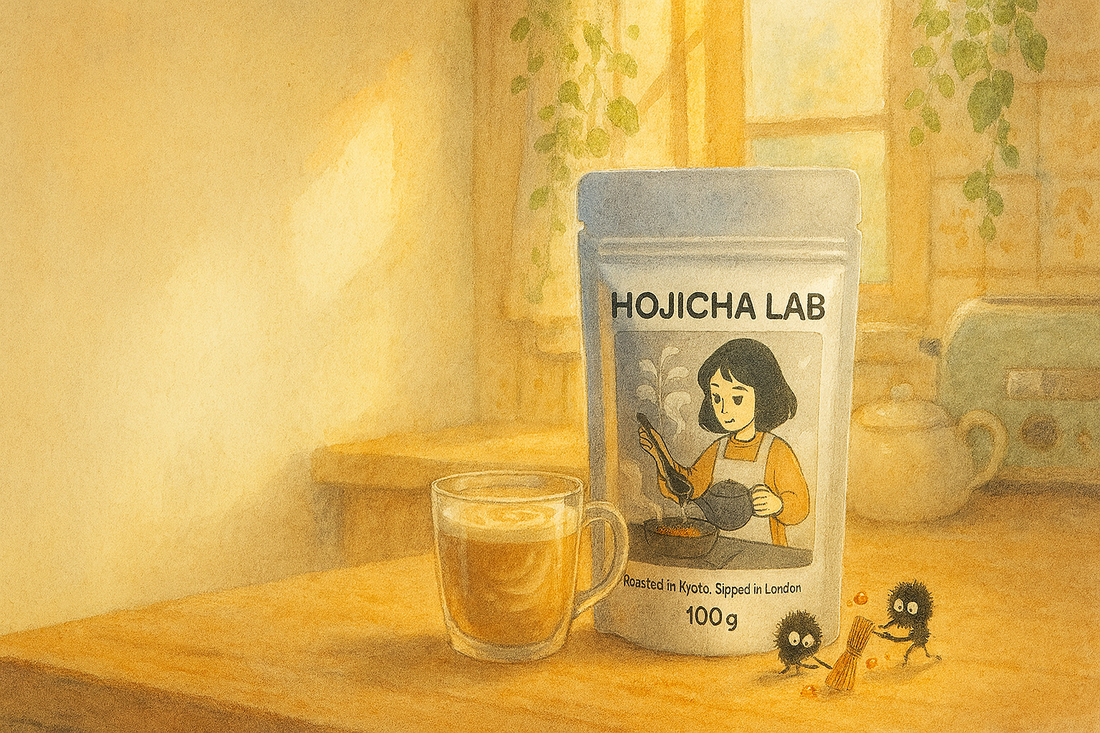
What Is Hojicha & Why It’s the Next Matcha
Hojicha 101: Your Cozy, Roasted Road Map to Japan’s Other Green Tea Star
Move over, bright-green matcha—there’s a new mellow hero in town. Hojicha (ほうじ茶) is a Japanese green tea that’s gently roasted after steaming, giving the leaves their signature chestnut-brown hue, a toasty-sweet aroma, and a naturally low caffeine count. Think of hojicha as matcha’s laid-back cousin: while matcha bursts onto the palate like spring grass and spinach, hojicha wraps you in autumn leaves, caramel, and campfire coziness.
Below you’ll find everything you need to become a hojicha pro—history, flavor notes, wellness perks, and practical ways to brew, bake, and sip. We’ve even sketched an infographic-in-words for those who prefer visual cues. Brew a cup, settle in, and let’s roast!
History
Edo Origins (late 1800s). While green tea had been Japan’s beverage backbone for over a millennium, hojicha’s story doesn’t kick off until 1920 in Kyoto’s Nishijin textile district. Merchants unsold on leftover bancha (late-season leaves) tossed them into a porcelain pot over charcoal, hoping to soften bitterness. The experiment produced a nose-tickling, mahogany brew that spread through alleyway tea houses like fragrant wildfire.
Post-war practicality. As Japan modernized after WWII, economical bulk bancha was still roasted to stretch supplies. Families loved the mellow, kid-friendly flavor; street vendors hawked steaming pots outside train stations, and “Hoji pots” became everyday kitchenware.
Café renaissance (1990s – 2010s). Tokyo’s third-wave coffee boom nudged tea artisans to innovate. Micro-roasters began treating tea leaves like specialty beans—dialing in time, temperature, even bean-style cupping notes. Lattes, chiffon cakes, and puddings flavored with hojicha popped up in Kyoto dessert bars, attracting matcha-weary Instagram explorers.
Global lift-off (2020s). Google Trends reports a 50 %+ YoY surge for “hojicha latte,” and baristas from London to Los Angeles have added smoky swirls to their menus. In the wellness world, low-caffeine calm is the new superpower, and hojicha wears the cape.
Flavor Profile
One sip = toasted hazelnuts meet whispered chocolate.
| Sensory Axis | Matcha | Hojicha |
|---|---|---|
| Color | Vivid jade | Warm maple-brown |
| Aroma | Fresh-cut grass, edamame | Campfire toast, cocoa nib |
| First-taste | Umami, vegetal sweet | Caramelized sugar, nutty |
| Mouthfeel | Dense, creamy micro-foam | Silky, light, broth-like |
| Finish | Slight astringency | Smooth, no bitterness |
Why so different? Both teas start as green leaves steamed to lock in chlorophyll. Matcha is then stone-milled raw; hojicha heads to the roaster. Maillard reactions caramelize leaf sugars and amino acids, muting grassiness and unlocking praline notes—much like coffee’s green-to-brown bean transformation.
Caffeine check. Roasting gently degrades caffeine, so a typical 8 oz hojicha clocks in around 7–10 mg—about a tenth of matcha and far below coffee’s 95 mg. It’s a bedtime hug rather than a rocket launch.
Health Benefits
- Lower caffeine, steady focus. Theanine survives roasting and partners with residual caffeine to deliver relaxed alertness—perfect for late-night studying or meditation without jitters.
- Antioxidant spectrum shift. Roasting converts catechins into theaflavins and thearubigins (similar to black tea), which help combat oxidative stress in slightly different pathways than raw green tea. Variety, it turns out, is antioxidant spice.
- Gut-friendly warmth. Anecdotally, many tea drinkers find hojicha gentler on sensitive stomachs. The mellow pH and roasted polysaccharides may soothe digestion compared to sharper, tannic brews.
- Calming aromatherapy. Research on pyrazines—aroma molecules formed during roasting—shows they can lower heart rate and promote relaxation when inhaled. Sip your way to slow breaths.
Remember: tea is a wellness ally, not a miracle drug. Always consult health professionals for medical advice.
How to Use
Everyday Brews & Beyond
- Straight-up cup: Loose-leaf or roasted kukicha (twig tea) in a kyusu teapot for a light, nutty session.
- Barista-style latte: Hojicha powder dissolves in water or milk like matcha—add steamed oat milk and a drizzle of maple for hug-in-a-mug vibes.
- Chilled flash brew: Pour hot concentrate over ice for an instant iced tea that never tastes watered down.
- Culinary wildcard: Sprinkle powder into brownie batter, panna cotta base, or smoothie bowls; fold loose flakes into shortbread for bonfire-cookie magic.

Pro Tips (Because You’re Now the Expert)
- Play with roast levels. Lighter roasts preserve a whisper of green-tea freshness; deep roasts deliver chocolate-lava richness. Try a flight tasting.
- Ice-shake for froth sans whisk. Toss powder, cold water, and a cube in a jar; shake 30 sec. Instant café crema.
- Latte art hack. Hojicha’s taupe canvas shows white micro-foam designs more clearly than matcha—great for hearts and tulips.
- Pairing palette. Caramel, fig, toasted sesame, dark rum, or soft cheeses (brie!) sing with hojicha’s smoky-sweet notes.
- Bedtime brew ritual. Dim the lights, roast marshmallows’ scent in your mug, queue a lo-fi playlist—then unwind.
Mini FAQ
| Question | Quick Answer |
|---|---|
| Does hojicha contain sugar? | None added—its sweetness is 100 % roast alchemy. |
| Is hojicha gluten-free & vegan? | Yes, pure tea leaves only. (Check flavored blends for extras.) |
| Can I reuse leaves? | Absolutely. Second steeps taste lighter and nuttier; add 15 sec each infusion. |
| Why is my brew bitter? | Water too hot or steep too long. Aim for <95 °C and 30 – 45 sec for leaves. |
Ready to Toast Your Taste Buds?
You’ve got the history, the flavor map, and a brew guide that can practically hang on your kitchen wall. The only thing missing is the tea itself. Snag our small-batch, Kyoto-roasted hojicha powder now and turn your next cuppa into a warm, toasty adventure.